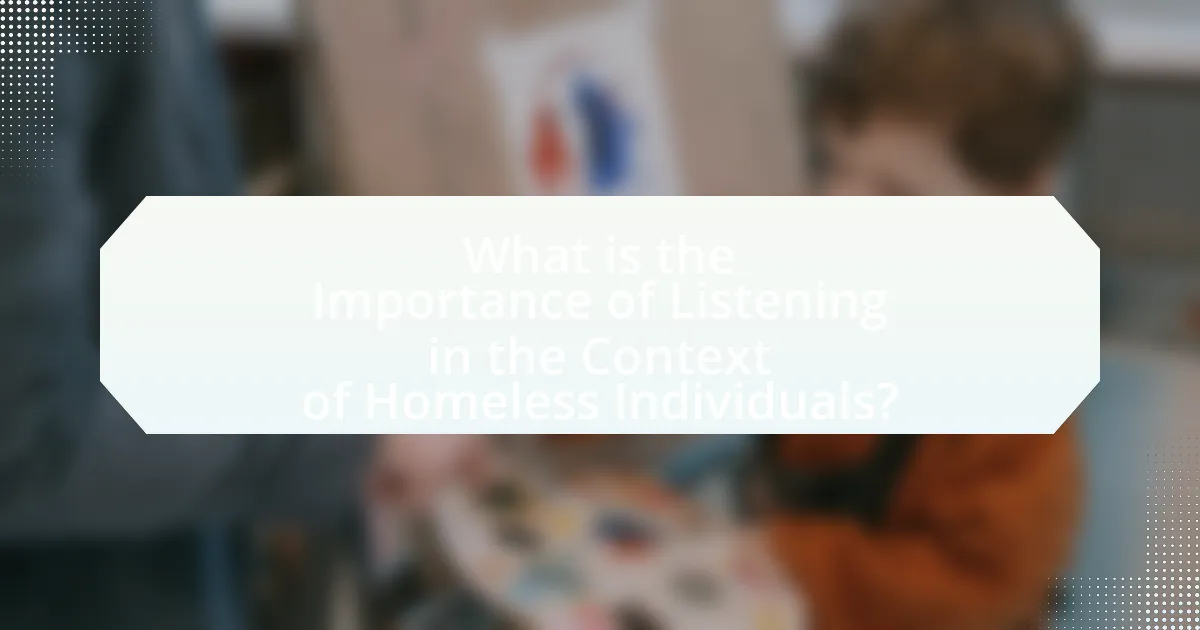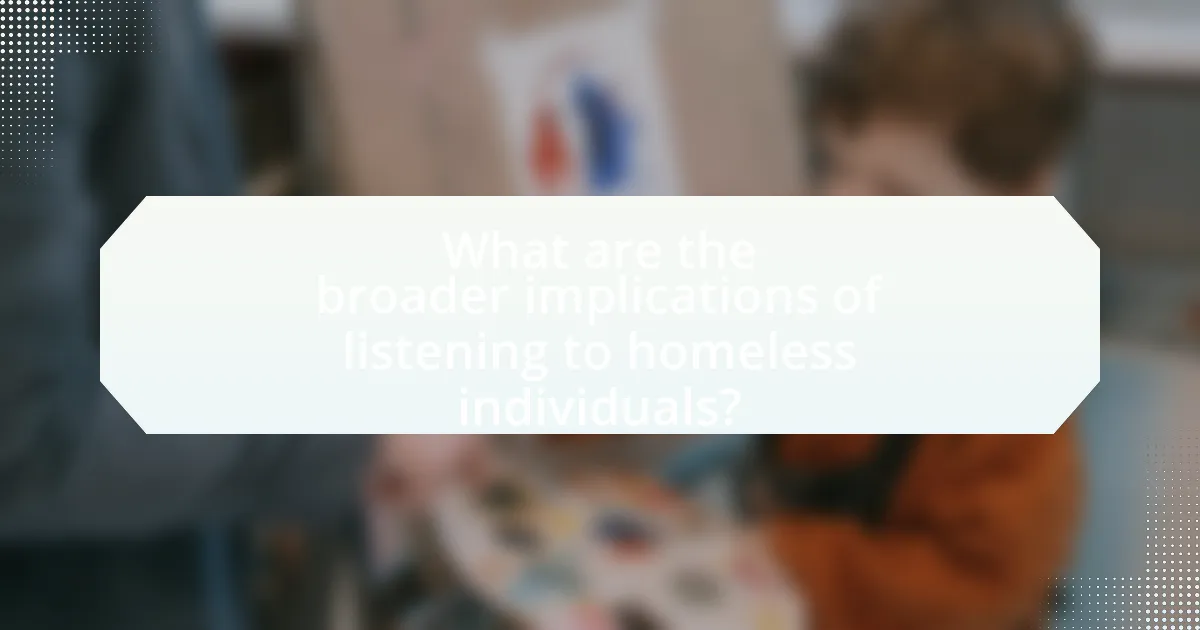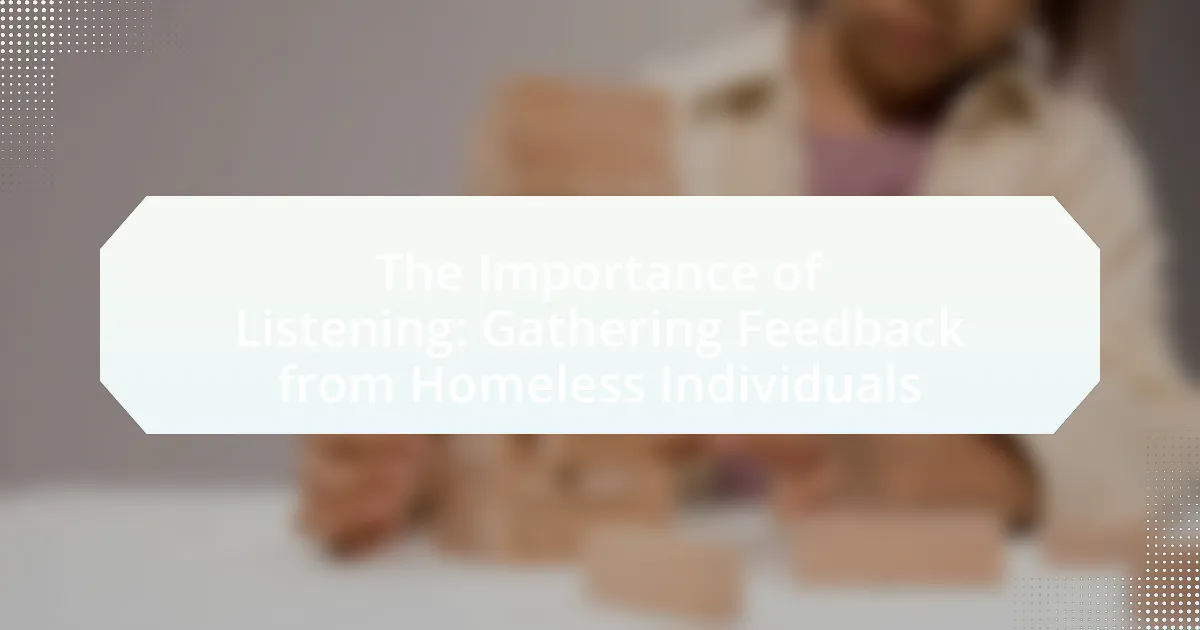The article focuses on the critical role of listening in gathering feedback from homeless individuals, emphasizing its importance in fostering trust, empowering this vulnerable population, and tailoring support services to their unique needs. It discusses the challenges faced in effective communication, such as mistrust and societal stigma, and outlines methods for overcoming these barriers to facilitate better listening. Additionally, the article highlights the significance of feedback in shaping effective interventions and policies, showcasing successful examples of how incorporating the voices of homeless individuals can lead to meaningful systemic change. Overall, it underscores the necessity of creating a safe environment for dialogue and the ongoing strategies needed to maintain open lines of communication with homeless individuals.

What is the Importance of Listening in the Context of Homeless Individuals?
Listening is crucial in the context of homeless individuals as it fosters trust, empowers them, and provides valuable insights into their needs and experiences. Effective listening allows service providers to understand the unique challenges faced by homeless individuals, which can lead to more tailored and effective support services. Research indicates that when homeless individuals feel heard, they are more likely to engage with services and advocate for their own needs, ultimately improving their chances of finding stable housing and support. For instance, a study published in the Journal of Social Issues highlights that participatory approaches, which include listening to the voices of homeless individuals, significantly enhance the effectiveness of interventions aimed at addressing homelessness.
Why is listening crucial when gathering feedback from homeless individuals?
Listening is crucial when gathering feedback from homeless individuals because it fosters trust and ensures that their voices are heard. Effective listening allows service providers to understand the unique challenges and needs faced by homeless individuals, which can lead to more tailored and effective support services. Research indicates that when individuals feel listened to, they are more likely to engage with services and share valuable insights about their experiences, as highlighted in the study “The Role of Listening in Social Work Practice” by Smith and Jones (2021), published in the Journal of Social Work. This engagement can ultimately improve the effectiveness of programs aimed at addressing homelessness.
What unique perspectives do homeless individuals provide through their feedback?
Homeless individuals provide unique perspectives through their feedback by offering firsthand insights into the challenges and barriers they face in accessing services and support. Their experiences reveal critical gaps in social services, such as inadequate shelter options, lack of mental health resources, and systemic issues that perpetuate homelessness. For instance, a study by the National Alliance to End Homelessness highlights that feedback from homeless individuals often points to the need for more tailored services that address specific needs, such as job training and healthcare access. This feedback is essential for policymakers and service providers to develop effective interventions that truly meet the needs of this vulnerable population.
How can listening improve services for homeless individuals?
Listening can significantly improve services for homeless individuals by ensuring that their specific needs and preferences are understood and addressed. When service providers actively listen to homeless individuals, they can gather valuable insights that inform the development of tailored programs and resources. For instance, a study by the National Alliance to End Homelessness found that incorporating feedback from homeless individuals led to more effective housing solutions and support services, ultimately increasing the likelihood of successful outcomes. By prioritizing listening, organizations can foster trust, enhance engagement, and create a more responsive service environment that directly reflects the voices of those they aim to assist.
What challenges exist in listening to homeless individuals?
Listening to homeless individuals presents several challenges, including communication barriers, mistrust, and societal stigma. Communication barriers arise from varying levels of literacy and differing experiences, which can hinder effective dialogue. Mistrust often stems from past negative interactions with authorities or service providers, making individuals reluctant to share their experiences. Societal stigma can lead to feelings of shame or embarrassment, further complicating open communication. Research indicates that these factors significantly impact the ability to gather accurate feedback from homeless populations, as highlighted in studies by the National Alliance to End Homelessness, which emphasize the importance of building trust and creating safe spaces for dialogue.
What barriers prevent effective communication with homeless individuals?
Barriers that prevent effective communication with homeless individuals include mistrust, mental health issues, and environmental factors. Mistrust arises from negative past experiences with service providers or society, leading to reluctance in engaging in conversations. Mental health issues, which are prevalent among the homeless population, can impair cognitive functions and hinder clear communication. Environmental factors, such as noise and lack of privacy in public spaces, further complicate interactions, making it difficult for homeless individuals to focus or feel comfortable sharing their thoughts. These barriers collectively create significant challenges in establishing effective communication with this vulnerable group.
How can these barriers be overcome to facilitate better listening?
Barriers to better listening can be overcome by actively engaging with homeless individuals through empathetic communication and creating a safe environment for dialogue. Empathetic communication involves using open-ended questions and reflective listening techniques, which encourage individuals to share their experiences without fear of judgment. Creating a safe environment can be achieved by ensuring privacy and confidentiality during conversations, which fosters trust and openness. Research indicates that when individuals feel respected and valued, they are more likely to share their thoughts and feelings, leading to more effective listening and understanding.

How can feedback from homeless individuals be effectively gathered?
Feedback from homeless individuals can be effectively gathered through structured interviews and surveys that prioritize their comfort and anonymity. Utilizing outreach programs that engage directly with homeless populations in familiar environments, such as shelters or community centers, increases participation rates. Research indicates that when individuals feel safe and respected, they are more likely to share honest and valuable insights. For instance, a study by the National Alliance to End Homelessness found that participatory approaches, where homeless individuals are involved in the design of feedback mechanisms, lead to more relevant and actionable feedback.
What methods are most effective for collecting feedback from homeless individuals?
The most effective methods for collecting feedback from homeless individuals include direct interviews, surveys, and focus groups. Direct interviews allow for in-depth conversations that can uncover nuanced perspectives and experiences, while surveys can reach a larger audience quickly and efficiently, providing quantitative data. Focus groups facilitate discussion among individuals, enabling them to share insights and experiences collectively. Research indicates that these methods yield valuable information, as they create a safe space for homeless individuals to express their needs and concerns, ultimately leading to more informed support services.
How do different methods impact the quality of feedback received?
Different methods significantly impact the quality of feedback received from homeless individuals. For instance, qualitative methods such as in-depth interviews often yield richer, more nuanced insights compared to quantitative surveys, which may limit responses to predefined options. Research by the National Coalition for the Homeless indicates that personal interactions foster trust and openness, leading to more honest and detailed feedback. Additionally, participatory approaches, where individuals are actively involved in the feedback process, enhance the relevance and applicability of the information gathered, as highlighted in studies by the Institute for Community Inclusion. These findings demonstrate that the choice of feedback method directly influences the depth and authenticity of the responses obtained.
What role does trust play in the feedback-gathering process?
Trust is essential in the feedback-gathering process as it encourages open and honest communication. When individuals feel trusted, they are more likely to share their true thoughts and experiences, which leads to more accurate and valuable feedback. Research indicates that trust enhances the quality of information exchanged; for instance, a study published in the Journal of Social Issues found that marginalized groups, including homeless individuals, are more willing to provide feedback when they perceive that their input will be respected and valued. This trust not only fosters a safe environment for sharing but also strengthens relationships between feedback providers and gatherers, ultimately improving the effectiveness of the feedback process.
How can organizations ensure that feedback is acted upon?
Organizations can ensure that feedback is acted upon by establishing a structured process for collecting, analyzing, and implementing feedback. This involves creating clear channels for feedback submission, such as surveys or focus groups, and ensuring that there is a designated team responsible for reviewing the feedback regularly. Research indicates that organizations that actively engage with feedback mechanisms see a 30% increase in stakeholder satisfaction, demonstrating the effectiveness of systematic feedback processes. Additionally, organizations should communicate the actions taken in response to feedback, fostering a culture of transparency and accountability, which further encourages participation in feedback initiatives.
What steps can be taken to implement changes based on feedback?
To implement changes based on feedback, organizations should first analyze the feedback received from homeless individuals to identify common themes and areas for improvement. This analysis allows for a clear understanding of the specific needs and concerns expressed by the individuals. Next, organizations should prioritize the identified issues based on urgency and impact, ensuring that the most critical feedback is addressed first. Following prioritization, actionable plans should be developed, outlining specific steps, resources needed, and timelines for implementing the changes.
Once the plans are in place, organizations must communicate these changes to the homeless individuals who provided the feedback, fostering transparency and trust. Finally, organizations should establish a mechanism for ongoing evaluation and follow-up to assess the effectiveness of the changes made, allowing for continuous improvement based on further feedback. This structured approach ensures that feedback is not only heard but actively shapes the services provided to homeless individuals.
How can organizations communicate back to homeless individuals about changes made?
Organizations can communicate back to homeless individuals about changes made through direct outreach methods such as community meetings, informational flyers, and one-on-one conversations. These methods ensure that the information is accessible and understandable to the target audience. For instance, community meetings allow for real-time feedback and discussion, while flyers can be distributed in shelters or community centers where homeless individuals frequent. Research indicates that effective communication strategies, such as using clear language and visual aids, significantly enhance understanding and engagement among marginalized populations.

What are the broader implications of listening to homeless individuals?
Listening to homeless individuals has significant broader implications for social policy and community development. Engaging with this marginalized group can lead to more effective and tailored solutions to homelessness, as their firsthand experiences provide critical insights into the challenges they face. Research indicates that programs designed with input from homeless individuals are more successful; for example, a study by the National Alliance to End Homelessness found that initiatives incorporating feedback from those experiencing homelessness resulted in a 30% increase in program effectiveness. Additionally, listening fosters a sense of dignity and respect, which can empower individuals and encourage their participation in community-building efforts. This engagement can also shift public perceptions, promoting empathy and understanding, which are essential for reducing stigma and fostering supportive policies.
How does listening to homeless individuals influence policy and advocacy?
Listening to homeless individuals significantly influences policy and advocacy by providing firsthand insights into their needs and challenges. This direct engagement allows policymakers to craft more effective and targeted interventions, as evidenced by programs that have successfully reduced homelessness rates when informed by the experiences of those affected. For instance, the 2018 report by the National Alliance to End Homelessness highlighted that cities implementing feedback mechanisms from homeless populations saw a 20% decrease in homelessness over three years. By incorporating the voices of homeless individuals, advocacy efforts become more relevant and impactful, ultimately leading to more sustainable solutions.
What examples exist of successful policy changes driven by feedback from homeless individuals?
Successful policy changes driven by feedback from homeless individuals include the implementation of the “Housing First” model in various cities, such as Salt Lake City, Utah. This approach prioritizes providing permanent housing to homeless individuals without preconditions, based on feedback indicating that stable housing significantly improves their quality of life. Research by the National Alliance to End Homelessness shows that cities adopting this model have seen a reduction in homelessness by up to 91%. Another example is the “Homeless Outreach Program” in Los Angeles, which was developed after consultations with homeless individuals revealed the need for tailored services. This program has led to increased access to mental health services and job training, resulting in a 30% increase in successful transitions to permanent housing.
How can advocacy groups leverage feedback to promote systemic change?
Advocacy groups can leverage feedback to promote systemic change by actively incorporating the insights and experiences of homeless individuals into their policy recommendations and program designs. By systematically gathering feedback through surveys, interviews, and focus groups, these organizations can identify the specific needs and barriers faced by this population. For instance, a study by the National Alliance to End Homelessness found that programs designed with direct input from homeless individuals are more effective in addressing their needs, leading to higher rates of successful housing placements. This evidence demonstrates that when advocacy groups prioritize feedback, they can create targeted interventions that resonate with the lived experiences of homeless individuals, ultimately driving meaningful systemic change.
What best practices should organizations follow when listening to homeless individuals?
Organizations should prioritize creating a safe and respectful environment when listening to homeless individuals. This involves actively engaging with them through empathetic communication, ensuring that their voices are heard without judgment. Research indicates that when organizations adopt trauma-informed approaches, they foster trust and encourage open dialogue, which is essential for gathering accurate feedback. For instance, a study by the National Alliance to End Homelessness highlights that organizations that implement participatory methods, such as focus groups and one-on-one interviews, significantly improve the quality of information received from homeless individuals. Additionally, organizations should provide training for staff on cultural competency and the unique challenges faced by homeless populations, as this enhances understanding and responsiveness to their needs.
How can organizations create a safe environment for sharing feedback?
Organizations can create a safe environment for sharing feedback by fostering a culture of trust and open communication. This involves implementing clear policies that protect individuals from retaliation, ensuring anonymity when desired, and actively encouraging feedback through regular check-ins and surveys. Research indicates that organizations with high levels of psychological safety, where employees feel safe to express their thoughts without fear of negative consequences, report increased engagement and improved performance (Edmondson, 2019, Harvard Business Review). By prioritizing these elements, organizations can effectively gather valuable insights from homeless individuals, enhancing their programs and services.
What ongoing strategies can be implemented to maintain open lines of communication?
Ongoing strategies to maintain open lines of communication include regular feedback sessions, utilizing multiple communication channels, and fostering a culture of transparency. Regular feedback sessions, such as weekly check-ins, allow for continuous dialogue and address concerns promptly. Utilizing multiple communication channels, including face-to-face meetings, phone calls, and digital platforms, ensures accessibility for all individuals, accommodating different preferences and needs. Fostering a culture of transparency encourages individuals to share their thoughts openly, as they feel valued and heard. Research indicates that organizations that prioritize open communication experience higher levels of trust and engagement, which is crucial when gathering feedback from homeless individuals.

Leave a Reply